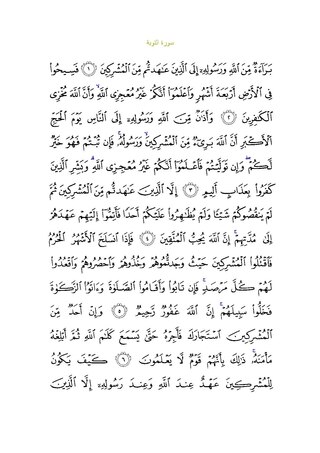
In Islam, Jahannam is the place of punishment for evildoers in the afterlife, or hell. This notion is an integral part of Islamic theology, and has occupied an important place in the Muslim belief. It is often called by the proper name Jahannam, but other names refer to hell and these are also often used as the names of different gates to hell. The term "Jahannam" itself is used not only for hell in general but for the uppermost layer of Hell.

The Israʾ and Miʿraj are the two parts of a Night Journey that Muslims believe the Islamic prophet Muhammad took during a single night around the year AD 621. Within Islam, the majority of Islamic scholars claim that the journey was both a physical and spiritual one. Islamic tradition believes a brief mention of the story is found in the 17th surah (chapter) of the Quran, called al-Isra', while details of the story are found in the hadith.

Al Imran is the third chapter (sūrah) of the Quran with two hundred verses (āyāt).

At-Tawbah is the ninth chapter of the Quran. It contains 129 verses and is one of the last Medinan surahs. This Surah is known by two names, At-Taubah and Al-Bara'at. It is called At-Taubah in light of the fact that it articulates taubah (atonement) and informs about the conditions of its acceptance.. The name Bara'at (Release) is taken from the opening word of the Surah.

Al-Anfal is the eighth chapter (sūrah) of the Quran, with 75 verses (āyāt). Regarding the timing and contextual background of the revelation, it is a "Medinan surah", completed after the Battle of Badr. It forms a pair with the next surah, At-Tawba.

Al-Kahf is the 18th chapter (sūrah) of the Qur'an with 110 verses (āyāt). Regarding the timing and contextual background of the revelation, it is an earlier Meccan surah, which means it was revealed before Muhammad's hijrah to Medina, instead of after.

Az-Zumar is the 39th chapter (surah) of the Qur'an, the central religious text of Islam. It contains 75 verses (ayat). This surah derives its name from the Arabic word zumar (troops) that occurs in verses 71 and 73. Regarding the timing and contextual background of the believed revelation, it is believed to have been revealed in the mid-Meccan period when persecutions of the Muslim believers by the polytheists had escalated.

Al-Qamar is the 54th chapter (surah) of the Quran, with 55 verses (ayat).The Surah was revealed in Mecca. The opening verses refer to the splitting of the Moon. "Qamar" (قمر), meaning "Moon" in Arabic, is also a common name among Muslims.

Al-Mulk is the 67th chapter (surah) of the Quran, comprising 30 verses. Surah Al Mulk emphasizes the greatness of Allah and His creation, urging believers to reflect on the signs of God's power in the universe.

The Covered is the 74th chapter (sūrah) of the Qur'an, with 56 verses (āyāt).

An-Nāziʻāt is the seventy-ninth sura of the Qur'an, with 46 ayat. Its name derived from the word wan-nazi‘at with which it opens. The root (n-z-‘) roughly means "to yank out with great force", although it can also mean "to yearn for" or "to yearn after".
Abū Hurayra ʿAbd al-Raḥmān ibn Ṣakhr al-Dawsī al-Zahrānī, commonly known as Abū Hurayra, was a companion of the Islamic prophet Muhammad and the most prolific hadith narrator in Islam.
Muhammad ibn Muslim ibn Ubaydullah ibn Abdullah ibn Shihab az-Zuhri, also referred to as Ibn Shihab or az-Zuhri, was a tabi'i Arab jurist and traditionist credited with pioneering the development of sīra-maghazi and hadith literature.
In Islamic tradition the two kiraman katibin are two angels called Raqib and Atid, believed by Muslims to record a person's actions.
Islam is an Abrahamic monotheistic religion teaching that there is only one God (Allah) and that Muhammad is His last Messenger.
In Sunni Islam, the Hadith of Gabriel is a ninth-century hadith of the Islamic prophet Muhammad which expresses the religion of Islam in a concise manner. It is believed to contain a summary of the core of the religion of Islam, which are:
- Islām (إسلام), which is described with the "Five Pillars of Islam,"
- Īmān (إيمان), which is described with the "Six Articles of Faith,"
- Iḥsān (إحسان), or "doing what is beautiful," and
- al-Sā’ah (الساعة), or The Hour, which is not described, but its signs are given.
According to Islamic tradition, the Quran was revealed to the Islamic prophet Muhammad by the angel Gabriel (Jibrail). The seven reading variants, translated as "styles", "ways", "forms" and "modes", are said to have been taught by Michael. Islamic scholars agree that the ahruf were styles used by the early Muslims to recite the Quran.
The Zabaniyah is the name of a group of angels in Islam who are tasked to torture the sinners in hell. They are mentioned appeared in many verses in Quran, With various names such as "Nineteen angels of Hell", "Angels of punishment", "Guardians of Hell", "Wardens of hell", and "Angels of hell" or "The keepers".

Bearers of the Throne or also known as ḥamlat al-arsh, are a group of angels in Islam.

Al-ʽArsh is the throne of God in Islamic theology. It is believed to be the largest of all the creations of God.














